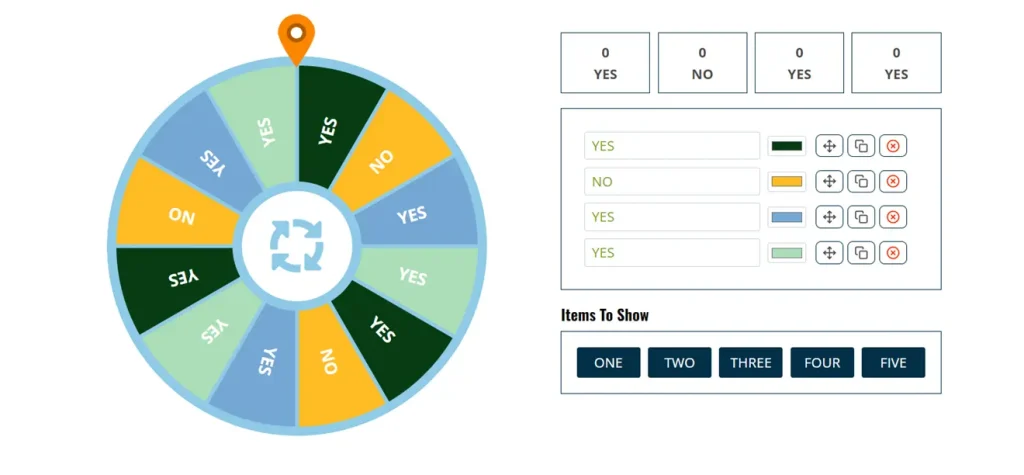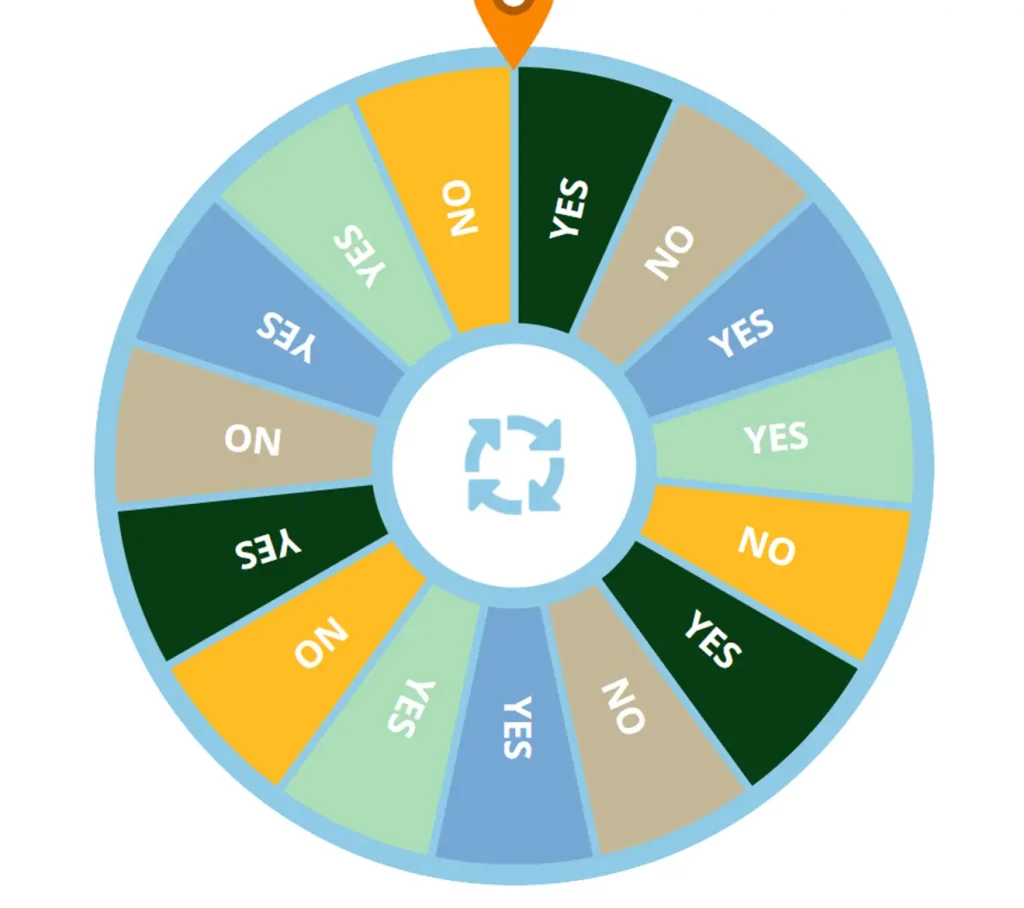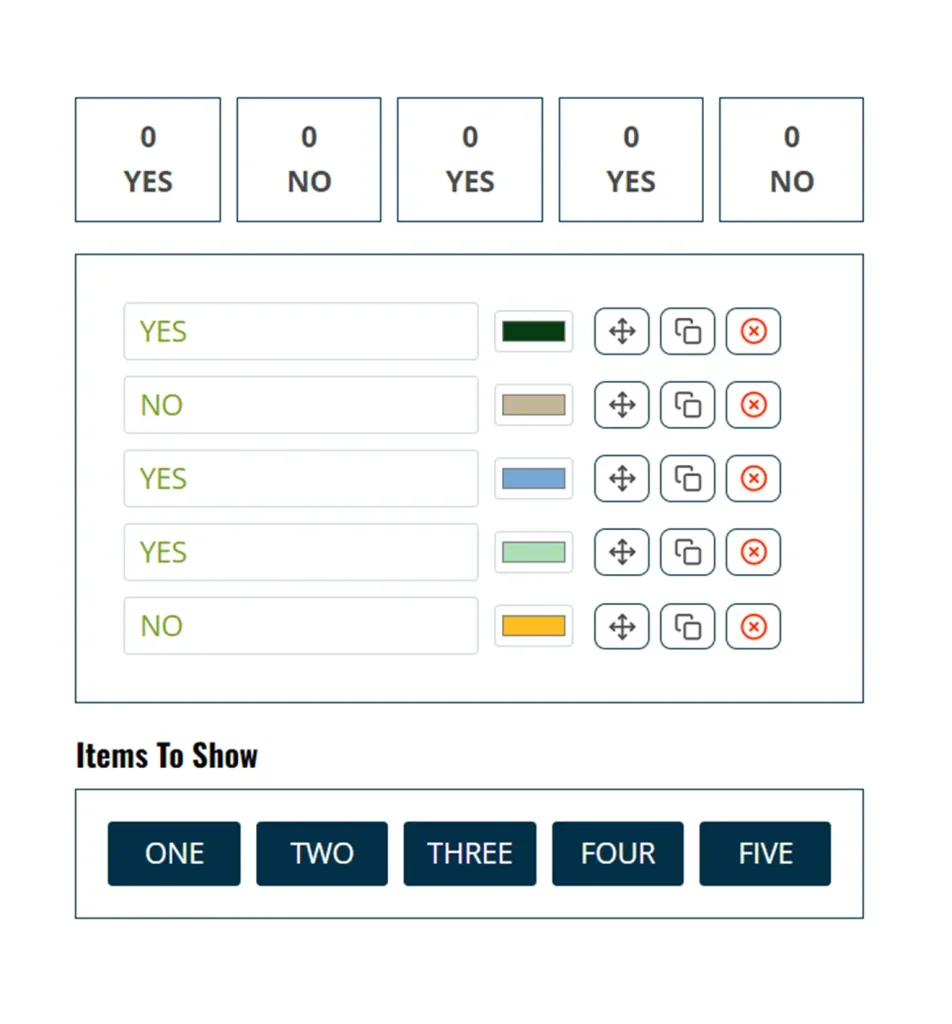Yes or No Picker: Spin the Wheel to Get Random Answer [2025]
Items to Show
Can’t decide between that new dress or the comfy sweats? Do you have to decide between that hot and spicy dish or a regular one? We’ve all been through such situations, facing tough choices that give us doubts.
You feel overwhelmed when you need to decide on a never-ending list of options. Luckily, technology has given us creative tools that help us ease the burden. This is where the fun and helpful tool “Yes or No Picker” comes in!
It’s your friendly neighborhood decision-making pal that helps you make the tough choices in your life. Now, no more letting your worries and concerns take over your every waking moment.
Just spin the Yes or Spinner wheel, and a randomly selected “yes” or “no” will eliminate your dilemma. It is a virtual spin on the old “heads or tails”Yes or No Flip game but with a bit more style!
Table of Contents
What is a Yes or No Picker?
The Yes or No Picker is a digital tool designed to assist users in making decisions. Instead of numbers, it has two (or three) slices: Yes, No, and Maybe (optional). It helps you to make a binary choice: yes or no.
This Picker Wheel operates on the principle of simplification, cutting through the noise of multiple options and focusing solely on the user’s preferences. By spinning the wheel, you get a random answer.
Benefits of Using Yes or No Picker
Here’s why you should consider incorporating the Yes or No Picker Wheel into your decision-making process:
- Breaks Indecision: Need help to pick between two options? The Picker wheel nudges you in a random direction. It overcomes analysis paralysis, helping you move forward.
- Quick Decision Making: Imagine you’re in a hurry and can’t decide which option you should you. It’s the time when Yes or No Picker comes in handy. It provides instant answers, helping you make decisions quickly without overthinking or hesitation.
- Free of Cost: Nothing in this world is free But you’re wrong here. The Yes or No Picker wheel doesn’t charge any registration fee to help you. It’s your true friend out of this mean world to help make choices.
- Overcome Biases: Another benefit of using the Yes or No Wheel is that your personal preferences, choices, and emotional attachments do not influence it. The wheel helps you to overcome biases and give an impartial answer. This factor leads us to make random choices that are solely based on chance.
- Adds a Fun Element: Decision-making doesn’t have to be a chore! The interactive nature of the picker wheel makes it a fun way to settle a debate. The element of chance makes the spinning process more enjoyable.
- Customization Option: This tool offers a customization option. It could be adjusted from spinning speed and duration to change the color and image of the wheel’s background.
- Icebreaker or Party game: The Yes or No Wheel can be a lighthearted way to break the ice at gatherings or add an enjoyment factor to parties. Imagine you’re playing using the truth and dare wheel with friends, and can’t decide which one to choose, here comes the Yes or No Picker to get a random challenge.
- Sparks Creativity: Use the Yes or No Spin Wheel for non-critical decisions, like choosing a movie genre or what to cook for dinner. It adds a fun twist and opens you up to new options. Maybe that “no” on trying that new restaurant will lead you to discover a hidden gem!
- Take the Guesswork out of Choices: Yes or No Spin Wheel brings a concept to life. You can tailor the tool to their specific needs by adjusting parameters such as weighting certain options or adding custom responses. Simply input your options; like choices for a weekend activity, personal dilemmas, or even career decisions to let the decision-maker wheel decide for you.
- Foster Connection: Yes or no pickers are used with yes or no questions related to a specific topic to spark conversation at parties or gatherings. This can be especially helpful for introverts or those who find small talk challenging. The lighthearted nature of the pickers helps people get to know each other and creates a relaxed atmosphere.
- Clarity in Answer: The algorithm of Picker Wheel doesn’t lie on creativity or logic; it gives up momentarily and lets fate play in your choices. This wheel spinner changes your mindset; helping you to view a decision with a dynamic view rather than a fixed mind. It’s a reminder that the journey is just as important as the destination, accept the clear answer from the wheel and it will unexpectedly pay you.
- Accessible to All: The Yes or No Picker is simple to use and accessible to everyone, regardless of age or technical skill. It can be accessed online, making it versatile and helpful in a variety of scenarios.

Limitations of Yes or No Picker
However, there are endless benefits of using Yes or No Picker but you have to acknowledge the limitations of using this spin wheel. Some of the potential drawbacks are the following:
- Simplification: While effective for some decisions, the binary nature of the tool may oversimplify complex choices. By relying on chance individuals may feel they are in control of fate. There would come a point where they’ll feel the outcomes do not align with their values and feel dissatisfied.
- Not Suitable for Critical Decisions: Another drawback is that the Yes or No Picker may not be well-suitable for complex decisions that require logic and careful analysis. This tool is useful for making simple decisions like where to go, what to eat, or what to watch, but not for those decisions that require mindfulness, provoking thoughts, and consultation with others.
- Overreliance on Chance: A primary limitation of a Yes or No picker is its reliance on pure chance. It provides no basis for informed decision-making. Important decisions often require careful consideration of various factors, which a simple random choice cannot account for.
How Does It Work?
Using the Yes or No Picker Wheel is intuitive and user-friendly. First, think of a question or choice you want to make. This could be something like choosing from simple things like what to wear, what to eat, should go outside, or bigger decisions like taking a new job offer, ending up in a relationship, and so on.
Make sure you have a clear question in your mind. There should be no doubts or uncertainty. Take a moment to reflect on each choice and your feelings about it.
Most Yes or No Wheels allow you to choose between a classic “yes or no” format or a “yes, no, maybe” format for situations where a little uncertainty is on the table. Customize the wheel as per your choice.
When you’re ready, spin the virtual wheel with your finger to see it move around multiple times. Wherever it ends, there is your answer! If it lands on Yes, take it as a sign to choose that choice. If it chooses No, skip that option and go on. The trick is to put complete faith in the wheel’s decision, and not.
Psychology Behind the Yes or No Wheel
The psychology behind using a picker tool can be explained through several psychological principles:
- Decision Fatigue: The human brain has a limited ability to make decisions. Choices meant to be made daily create fatigue of choices which, in turn, involves the entire neural system and many neurons. The Yes or No Picker tool lessens the cognitive load and decision fatigue by making the choice a binary choice of ‘yes’ or ‘no’.
- Reduction of Anxiety: Uncertainty is the mother of anxiety and stress. The tool works to provide direct and easy answers to overcome anxiety associated with making difficult choices. In addition, although the outcome could be random, being given a decision will give these users a sense of relief and closure.
- Loss Aversion: Humans are inherently averse to losses and seek to avoid them whenever possible. The perpetual spinning of the Yes No Generator tools also changes the way the decision is seen, where a consequential decision appears to be just a game of chance. This makes it easier for the individuals to accept the outcome, whether or not it matches their initial preferences.
- Randomness and Probability: The effect of the picker tool involving randomness plays a psychological trick on probability and chance. The fact that the result is unpredictable does not negate the people’s perception that it is fair and neutral, which in turn makes them more likely to accept the decision.
- Anchoring Effect: The Yes or No Picker tool is a reference frame or a starting point for the decision-making process that helps to quick mind choice process. Even if the users will later override the tool’s decision, it influences their subsequent choices by anchoring their initial preferences.
- Cognitive Closure: Humans have a natural tendency to seek closure and resolution, especially when faced with uncertainty. The Yes or No Picker offers a quick and decisive resolution to dilemmas. It provides users with the closure they need to move forward confidently.
- Illusion on Control: While the outcome of a yes or no wheel is purely random, people may perceive a sense of control over the process. The act of spinning the wheel create a psychological illusion of agency. This can be comforting for individuals who prefer to feel in charge of their decisions.

Yes or No Picker Use Cases
Yes or No Picker is used to decide dumb things at home, classroom, at work, or at some sort of gathering. Some use case scenarios are the following:
- Daily Choices: Use a Yes or No Wheel Decide for everyday decisions such as what to have for dinner, which outfit to wear, or whether to go for a walk.
- Decision Deadlocks: In group settings where consensus is needed but opinions are divided, use a Yes or No Spin Wheel to break the deadlock and move forward.
- Financial Decisions: For simple financial decisions like whether to make a purchase or stick to a budget, a Yes or No spin tool provides clarity.
- Team Building: During team-building exercises, use the picker for fun activities or lighthearted challenges to encourage teamwork and communication.
- Relationship Dilemmas: When unsure about a relationship decision, such as whether to ask someone out or end a relationship, a Yes or No Spin Wheel offers guidance.
- Career Choices: Use a Picker Wheel when deciding whether to accept a job offer, pursue a career change, or take on a new project.
- Creative Ideas: When brainstorming creative ideas, use a picker wheel to select which idea you have to continue further randomly.
- Personal Growth: When contemplating self-betterment goals or habits to adopt, use a Yes or No Spin Wheel to prioritize where to focus your efforts.
- Travel Plans: When planning a trip and faced with various destination options or activities to include, use a Yes or No Wheel Picker to make quick decisions.
- Social Events: When deciding whether to attend a social event or accept an invitation, use a picker tool to help make the decision.
- Classroom Activities: Use this Twister Wheel while randomly selecting students for a task, project, class discussion, or even the order of presentations.
- Game Night Decisions: During game nights with friends or family, use the spinner to decide on game rules, player turns, or even whether to play another round. It can keep the night lively and unpredictable.
Tips to Use Yes or No Picker Effectively
Here are some tips to get the most precise answers from your Yes No Picker:
- Visualize the factors influencing your decision engaging your head and heart before using the tool.
- Make up a clear question in your mind. Keep it crystal clear, no room for guessing, ya feel?
- Once the decision is made, commit to it truly.
- After making a decision, reflect on the process and outcome to learn and improve future decision-making.
- If you’re not satisfied with the answer, repeat your spin turns.
- Come back toward the Picker Wheel whenever you feel stuck or overwhelmed while making decisions. It will give you instant clear answers.
- Before spinning, make sure everyone involved is happy to accept the outcome. This sets expectations and supports the fairness of the decision.

Future Trends of Yes or No Picker Wheels
As with technological advancement, picker wheels are also evolving. One of the current trends for Picker Wheels is its integration with social media platforms. You can share the outcome of your wheel on your Instagram, Facebook, or TikTok.
For future Yes or No Picker holds exciting possibilities. You can anticipate advancements such as:
Integration with AI
In the long run, artificial intelligence (AI) and machine learning are taking over so much of what gives humans a feeling of purpose. Integration of AI algorithms will enable wheel pickers to provide more intelligent and personalized decision suggestions based on user inputs and past decisions. This might make wheel pickers much more personalized and useful.
Predictive Analytics
Looking ahead, we may expect major changes in wheel picker technology. With the advancement of artificial intelligence, future wheel pickers may be able to predict your preferences and customize your choices on the wheel accordingly. We may also see more interactive and immersive wheel pickers, perhaps in the form of virtual or augmented reality.
Gamification and Entertainment
Yes or No Picker Wheels could become more gamified and entertaining. They might incorporate features like points, rewards, or challenges to make the experience more fun and addictive. There could be new games and apps based on picker wheel technology, especially for younger audiences.
Conclusion
The Yes or No Picker Wheel is a playful yet practical approach to decision-making, providing users with a fun and interactive tool to go through life choices. While not a one-size-fits-all solution, it can be a valuable resource in breaking decision paralysis and bringing clarity to uncertain situations.
So, whether you’re pondering over what movie to watch or behold a major life decision, give the Picker Wheel a spin and let chance guide you toward your answer. It might just be the push you need to break free and make a choice!
